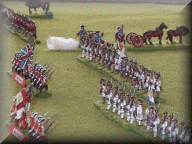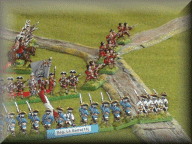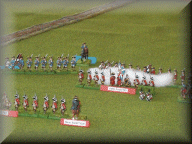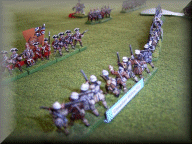History,
they say is written by the victor. If
so then this battle report should be a joint effort since I hope that the
game, my first in Hong Kong was a success – for battlefield winner and
loser alike.
 Elliot
Woodruff’s debut game in Hong Kong was set in the middle of the eighteenth
century – with a French force defending a line against a numerically
superior Austrian one. The rules
used were Age of Absolutism written by Birmingham wargamer, Roger
Underwood, complete with battle and terrain generation modules and army
lists for each side. Elliot
showed off his Austrians and John supplied the French.
Elliot
Woodruff’s debut game in Hong Kong was set in the middle of the eighteenth
century – with a French force defending a line against a numerically
superior Austrian one. The rules
used were Age of Absolutism written by Birmingham wargamer, Roger
Underwood, complete with battle and terrain generation modules and army
lists for each side. Elliot
showed off his Austrians and John supplied the French.
The
Austrians gained the initiative, having a ‘good’ commander while the
French, with only a ‘poor’ one, struggled to find a suitable defensive
location and when at last they did – they did not have the time to build
any redoubts.
The scene was set – together with some very Italian looking
buildings and poplar trees. The
pre-game build-up and terrain laying complete the game commenced – egged
on by a rousing round of applause from the neighbouring DBM game to signify
the first turn.
The Austrians refused their left flank, while infantry advanced in
the centre and massed cavalry advanced on the right.
The French held high ground along the centre and left with their
cavalry on the left flank.
 With
typical élan, the French cavalry (3 brigades: 2 cuirassier and 1 hussar)
advanced and charged the Austrians. Unfortunately
the hussars hit an Austrian cuirassier brigade and were routed in short
order. The first line of French
cuirassiers hit the leading brigade of Austrians only to be beaten on the
dice. This left the French left
wing “shaken” and obliged to retire.
The next turn the Austrians pursued and halted, only to be charged by
the French second line cuirassiers whose commander managed to muster
sufficient “PIP”s to delay the obligatory withdrawal.
The French gained the advantage and the Austrians routed – so
honour at least for the French cavalry.
With
typical élan, the French cavalry (3 brigades: 2 cuirassier and 1 hussar)
advanced and charged the Austrians. Unfortunately
the hussars hit an Austrian cuirassier brigade and were routed in short
order. The first line of French
cuirassiers hit the leading brigade of Austrians only to be beaten on the
dice. This left the French left
wing “shaken” and obliged to retire.
The next turn the Austrians pursued and halted, only to be charged by
the French second line cuirassiers whose commander managed to muster
sufficient “PIP”s to delay the obligatory withdrawal.
The French gained the advantage and the Austrians routed – so
honour at least for the French cavalry.
 Meanwhile
the Austrian centre moved forward steadily.
The Austrian gunners were a little rusty to say the least.
Their French counterparts were much more accurate and the lead
Austrian infantry brigade soon suffered casualties.
They made it to the French line and suffered dearly in the fire fight
which followed. Seeing the
Austrians on the verge of breaking, the French infantry tested to charge.
Successfully. The
Austrian line wavered but passed the response test subject to shooting at
long range not short. With five
d20s requiring a dice 4 or less, the charge was in the balance.
The Austrians fired; one “4” forced a charge-in test – and the
charge fell short. A desultory
fire fight followed, causing the battered Austrian line to withdraw
voluntarily. The Austrian C-in-C
got too close only to be wounded when the French line turned their sights on
his HQ.
Meanwhile
the Austrian centre moved forward steadily.
The Austrian gunners were a little rusty to say the least.
Their French counterparts were much more accurate and the lead
Austrian infantry brigade soon suffered casualties.
They made it to the French line and suffered dearly in the fire fight
which followed. Seeing the
Austrians on the verge of breaking, the French infantry tested to charge.
Successfully. The
Austrian line wavered but passed the response test subject to shooting at
long range not short. With five
d20s requiring a dice 4 or less, the charge was in the balance.
The Austrians fired; one “4” forced a charge-in test – and the
charge fell short. A desultory
fire fight followed, causing the battered Austrian line to withdraw
voluntarily. The Austrian C-in-C
got too close only to be wounded when the French line turned their sights on
his HQ.
But
this was all to no avail. The
Austrian left wing advanced to engage the French right and, before long the
French had suffered 50% casualties in terms of elements lost/shaken commands and were forced to quit the field –
albeit in good order.
terms of elements lost/shaken commands and were forced to quit the field –
albeit in good order.
And
so the battle ended – after 8+ turns and action on almost every turn.
Unsurprisingly the Austrian numerical superiority eventually told
against the French but it was not a totally one sided victory.
The Austrians lost a cuirassier brigade and a brigade and 1 ½
brigades of infantry (3¾ Army Points out of 24 – so over 12%) – and
this could be telling in a campaign situation (indeed, another lost brigade
and the Austrians might even have considered withdrawal).
French losses in terms of routed APs came to about 5-6 APs (nearly
33%) - so the decision to withdraw was a sensible one.
The casualties in percentage terms looked right for both winner and
loser alike.